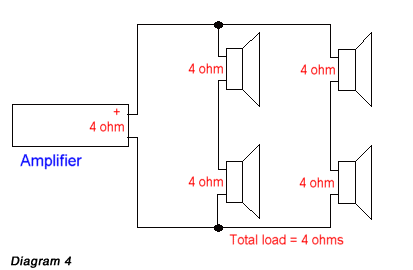Many times you are faced with hooking up speakers to a power source be it a guitar head,
power amp or mixer and you need to consider the speaker impedance.
Speaker impedance or load can mean the difference in getting the most out of an amp or
burning the amp up from overload. So here are some things to consider:
Most speakers today are ether 4, 8 or 16 ohms so connecting a speaker to an amplifier
becomes pretty simple. Checking with the amps recommendations we can determine which
impedance will work best. But what happens when we want to connect more than one speaker
to an amp?
Basically there are just two ways to connect multiple speakers together, series or parrallel.
Connecting speakers in series will allow the impedance load to be increased so allowing
for more speakers to be connected. But there are disadvantages. One will be the that all
speakers are dependent on the failure of just one speaker. So when one speaker fails the
others no longer get a signal so no sound. Also the distortion can be increased and the
damping factor decreased due to the interaction between the speakers.
Here is a simple diagram of a series wiring. The individual impedance's are added together
to get the total impedance.
In this example the two 4 ohm speakers now become an 8 ohm load.
In Parallel wiring each speaker load is cut in half. So for the two 8 ohm speakers,
the total load now becomes 4 ohms. This is again quite easy when dealing with
speakers of the same impedance, but becomes a challenge when working with different
impedance loads. This and the problem of the number of speakers that be connected before
the impedance becomes too low are the biggest drawbacks of parallel wiring.
However, it is still by far the preferred method due to the reliability and sound quality.
Most Pa cabinets offer a parallel jack on the back for connecting a 2nd speaker to the line.
These jacks are in parallel to each other.
In this example the two 8 ohm speakers are now a 4 ohm total impedance .
There is another option. Series-Parallel mode. This mode offers the option of more
speakers to be used such as in a 4x12 guitar cabinet. The wiring is a bit more complicated
but still pretty straight forward.
This type of wiring can offer a total cabinet load equal to the individual load of each speaker.
The diagram above shows us that the 4-4 ohm speakers now offer a total 4 ohm impedance.
We hope this has been of some help in choosing the correct wiring or speaker configuration
to achieve the best sound from your amp. Make sure to check your amp's specifications to see
what the minimum recommended impedance of your amplifier is. Most power amps for example
will work fine at 4 ohms but cannot handle a 2ohm load. That is were the problems can occur.
Note again that most speakers have parallel jacks on the back so when hooking two 8 ohm
speaker cabinets together they will be a 4 ohm load.
Thanks and happy hunting.


